What is "Menhera"? It is primarily a term to connect people who seek mental wellbeing. It originated on 2chan's mental health board as what basically amounts to slang for "mental healther," and has since evolved into "a subculture centered around a certain style of vent art as well as fashion featuring it" (menheratic).
I highly encourage anyone who is interested in learning more about menhera to check out the now defunct blog Menheratic's list of resources. A lot of their information is sourced from menhera.jp, an also now defunct Japanese site all about connecting menhera. There are also a few tumblr posts and blogs dedicated to information and news about Menhera in English. This post by the menhera info archieve has some additional information, and I reccomend checking out their blog as well.
Where do art and fashion fall into this? Art and fashion are simply two forms of self expression. Of course, there are many ways of self expression, ones that aren't art or fashion, but vent art is often tied closely with Menhera since art therapy has generally been encouraged as a healthy way to cope within the subculture. Even cute art is accepted, as "cute people aren't immune to suffering," (menheratic) and a lot of people find that it makes them feel better.
As for fashion, it is a way to literally wear your heart on your sleeve. Menhera fashion only really requires some kind of mental health theme to it, especially with vent art prints. It usually consists of a top with some kind of big vent art print (often oversized and paired with a short bottom), printed legwear or some kind of tights, medical accessories, subtle bondage gear, and comfortable flat shoes (often platforms). Light makeup is also common. Nothing over the top, usually simple everyday makeup with lots of blush under the eyes to accentuate the feeling of being fragile (often called byojaku). Wearing anything gory, triggering, or overly costumey is frowned upon when it comes to Menhera in fashion.
Side note for anyone too lazy to go through the resources, "Menhera" is sometimes used as slang for someone, especially a woman, who is "troublesome," an "attention whore," "cute but psycho," or a "yandere." It is important to remember that people like this are people, people who might also seek mental wellbeing, and it is dangerous to gatekeep in what way or how much someone is suffering to consider their problems as real problems. As such, "menhera" should not be used as a way to turn people's issues into a word for an archetype of people you don't like or find toxic. However, the term "menhera kei" (menhera-type) is more strongly associated with the negative steriotype, so it is best to avoid adding "kei" after menhera. Mental health is a broad category, so it's not fair to apply a negative steriotype to anyone who seeks mental wellbeing.
Of course, it's also important to note that Menhera is inherently pro-recovery. There is not one single path to recovery and recovery doesn't look the same for everyone, but doing things that might trigger others (like posting real images of self harm) opposes the entire point. Usually people who do this and associate it with Menhera are just misinformed.
This is still unfinished :)
This will be a tutorial for buying things from Taobao, since it's difficult to do so if you don't live in mainland China.
Taobao, in simple terms, is like Chinese Amazon. I should mention, if you are not in mainland China it may be difficult to use Taobao. Taobao is all in Chinese and often blocks you by asking you to sign in. Just back out or close out of that or inspect element it away if you don't have a way to sign in. I don't think it's worth it to try to figure out how to sign in, I've tried with the Taobao app and it always marks my account as suspicious, even if I use a VPN and it forces me to verify that I'm a real person by... asking me to show my mainland China citizen ID. In other words, Taobao is notoriously hard on foreigners. For that reason, I'll make it easier for you!
The first step is to get familiar with Taobao. It's all in Chinese so if you don't know anything, it's difficult to navigate. You can translate everything if you have a translator plugin or Google Chrome, but tbh you can get by without needing to read anything. Side note as well, Taobao has a worldwide version that might show less results someimes, you can change it if you want, but you don't have to. Taobao World will try to kick you out less if you'r a foreigner.
Now, how to find stuff you like. To search on Taobao, you should use search terms in Chinese. You can use google translate or ask someone who knows Chinese if you don't know Chinese yourself. Sometimes when you try to search for things, it will just redirect you to the homepage or ask you to log in. To bypass this, I just search on Google "Taobao [chinese search term]." I've also compiled a list of shops I've used before, so hopefully that makes it a lot easier for you to find things you like! If clicking on something redirects you to the Taobao homepage, you can right click and copy the link and paste it into the proxy service. By the way, shops on Taobao (not taobao world) will not show you every item right of the bat on the homepage. Find where it says "更多>" (More>) and click that.
 The same store in Taobao World (left) and regular Taobao (right) with where to click to see more items circled. Open the image in a new tab to see it better.
The same store in Taobao World (left) and regular Taobao (right) with where to click to see more items circled. Open the image in a new tab to see it better.
To buy off Taobao as a foreigner, you should use a proxy service. CSSbuy is the one I use, but there are a lot of them out there. I will explain the process for anyone who has never used a proxy service. Just grab the link of Taobao products you like and plug them into the proxy service's search bar, from there you can add them to your cart and check everything out like any normal online shop. After buying everything you want, an agent will order everything for you on Taobao and send everything to the proxy's warehouse. Once everything is in your warehouse, you can order everything to be packed into a parcel. Be mindful of shipping costs, what can get through customs, and any taxes that may be applied. If it helps, I like to order everything to be vaccuum packed into a bag and sent via China Post SAL. I'm in Texas and everything usually arrives within 2 weeks.
I hope this helps! Usually if you have any problems you can just contact the proxy service's agents and they will help. Be mindful that not all of them speak English very well, so try to be clear when communicating to them, and be respectful.
Ok so that was slight clickbait. I am learning Japanese and translating manga to help me (I will elaborate more). When I started though, I only really knew how to read hiragana and katakana. I hope this will serve as an abstract guide to anyone who was like me before starting out.
You NEED to have an interest in learning Japanese. It's a difficult language, but there are a lot of resources out there! I will give you an idea of where to start though, specifically for the purpose of translation. Manga translation is a great way to practice, but you really need a lot of motivation if you're doing this solo, and translation is an art in itself. This is not really a step-by-step, but it might give you an idea of how I do things.
Motivations
Japanese is one of the most difficult languages to learn as an English speaker, so you need to have solid motivations to keep you going. You can't just AI your way through translation, which I will explain in a different paragraph.
I've had an interest of Japanese culture since I was 11 years old or so, and as such, I've enthusiastically consumed a buttload of Japanese media without understanding a thing, unless I was lucky enough for there to be subtitles. I'm 20 now, and I want to be able to sing along to my favorite songs and understand the lyrics, I want to read semi-obscure mangas without having to pirate them or deal with shitty translations, I want to voice support for my favorite artists in their native language, I want to understand the nuances of different speech patterns in my favourite animes, I want to read long informative articles and posts in Japanese without relying on google translate, and I would like to visit Japan someday.
I feel like a lot of people cringe when you tell them you're learning Japanese since it's a stereotype of every annoying weeb, but I think wanting to interact with your favorite media and topics in their native language is a good motivation. Of course, it's always important to be respectful and open to learning, especially when delving so deep into a culture that isn't yours.
As for why I decided to start translating manga... I really wanted to read the anthologies for Bungou Stray Dogs but a lot of them were untranslated or very hard to find in English. As such, I decided to take matters into my own hands and finally start taking learning Japanese more seriously. This is NOT the best way to lean Japanese, not at all, but it's how I started because I'm built different (autistic), or something.
Getting Your Hands on Manga Raws
Of course, first you need a manga to translate. I buy them off bookwalker.jp, if you don't know Japanese you can still make an account by using google translate. I just used Google Translate's camera feature and held up my phone to my computer screen. It's a little silly, but it got the job done. From there, you now have access to thousands of manga in their native language. It helps if you already have interest in some obscure untranslated series, but you could try looking around or find something to retranslate.
Yeah, you have to buy the manga. You're supporting the artist directly this way, okay? It's usually cheap. Once you buy the manga you want, if you plan on editing it, you're gonna have to download the manga to your PC. It's tricky, but it's possible! While you can screenshot each page, the quality will suck. I use this method [archive] [github]. Please do not reupload the original Japanese version in full, manga ebooks are very cheap and mangakas usually need the money, also it's illegal. This is just how to get the raws for translation, we support artists in this house!
SFX and learning hiragana/katakana
Ok, you have the manga and the motivation, now what? First things first, I mentioned I knew hiragana and katakana. Japan uses 4 writing systems: hiragana, katakana, kanji, and roumaji. I learned hiragana and katakana on tofugo by following their guide, you can learn it the same way if you follow all their steps! It only takes a few hours or days to learn it all. Why should you start here? It's not only a good skill to have, but it will help you translate sound effects. SFX are often handwritten or stylized, so Google Translate is pretty bad at recognizing them. A lot of manga translations ignore the sound effects, but I personally find that they enhance the experience and add a lot of context and immersion to certain scenes.
SFX in manga are often onomatopoeic and mimic the sound they represent, but it's really difficult to understand it if you're not a native speaker. As such, I recommend using The Jaded Network, a huge online manga SFX library. There are more SFX guides out there, but The Jaded Network is probably the best one. It's a good way to practice reading handwritten hiragana and katakana, just copy them down (add Japanese to your phone's keyboard languages and do it that way, you can also do it on your PC or use an online keyboard but it's trickier) and plug them into The Jaded Network and choose the sfx that fits best. This guide is really good at teaching the basics of SFX translation.
You can type the SFX into a Google Docs, plug it into The Jaded Network, and type what the meaning along with its roumaji spelling next to it in your doc. Be mindful of the context in which it occurs.
Translating dialogue: Part 1, Don't AI Translate Everything
I must preface this section by saying: DO NOT translate everything with ChatGPT or Google Translate, PLEASE! You can use them as tools or crutches, but PLEASE I beg of you do not AI translate manga, it sucks so bad and you're not going to learn anything. Why does it suck? Japanese has a lot of particles and such and a sentence structure that is difficult to near impossible to translate directly. It carries a lot of suggestions of tone and closeness between characters that an AI will power through and ignore. Not to mention puns, jokes, and references will be absolutely butchered. Japanese is very reliant on the context of conversation, AI is ignorant of this and will occasionally produce clunky and nonsensical phrases.
I hope I've hammered in why pure AI translation is bad. If you still don't get it, AI translate an entire manga and realize how boring and confusing the dialogue is. Translation is an art of it's own and learning a language takes a lot of time and effort. I will explain my process of starting out with translations now, which does include Google Translate and ChatGPT, but more like proofreaders or tools to speed up the more dull parts of the process without doing the bulk of the work. I will explain how.
Translating dialogue: Part 2, Basic Japanese Grammar
We all start somewhere. You need to understand basic sentence structure to be able to translate Japanese.
For translations, you might want to focus on learning what particles are. Particles provide context in a sentence, and tell you how each word/thing is interacting with each other. Particles in English are stuff like “and,” “in,” “to,” and so forth, but in Japanese there are a lot more and all of them are important. You don't need to know all of them right off the bat, but it's best to have a basic understanding. Here's an article that goes over the basics, and if you're really invested, I recommend this book, A Dictionary of Japanese Particles. Tofugu goes in depth on each particle as well, or you can look up a cheat sheet online. Particles are complicated but the more you see them and read about them, the better you will understand them!
You might also want to know basic existence verbs and word forms. Here's a quick guide on the basic verbs that indicate existence: desu, aru, and iru. Here's one that goes over the different basic tenses. Why should you know this? It'll make this method of beginner translation easier. I should repeat, this is NOT the most optimal way of learning Japanese, but it is a way to speedrun your way to start translating manga. At least, it's how I did it.
Anyways, assuming you know the very basics of japanese sentence structure (please study more in your own time, look through the source list I provided at the beginning), let's start!
Translating dialogue: Part 3, The Process
This is just how I do it, it's a good way to get used to Japanese and learn new vocabulary. First, I get all the text from the page of the manga straight to a Google Doc. I usually just take pictures with Google Translate and copy paste the Japanese characters along with the roumaji into it to save time (though if you want to practice reading, you can do it by hand), and sort them by page and speech bubble. After that, I usually list out all the words, and use Jisho to look up each word and write the definition. You can copy paste a full sentence in Japanese characters into Jisho and it will separate each word for you with definitions for each one too, it's awesome.
After writing out each definition, I use what I know about grammar and particles to put it all together! If it's a longer phrase, I use ChatGPT and Google translate to double check it for me since I'm scared of real people. ChatGPT is good for this because you can use it to ask it questions or explain colloquial phrases. I reccomend HiNative to help you if you need a real person to explain something to you, or look at past people's questions. Tanoshii Japanese, Japanese Stack Exchange, Maggie Sensei, Japanese With Anime, romajidesu, and japanese.livejournal, are all resources I have used to help me.
This is a nice way to get used to Japanese as a total beginner and get something out of it at the same time. You will notice that over time, there will be less and less words you need to define for yourself with Jisho. Of course, I recommend taking some kind of more serious lessons if you want to learn Japanese, this is just a way to practice and get started. I'm a beginner myself, so I don't feel comfortable giving a full Japanese lesson here.
The process of translating manga is very nuanced, but luckily I've found and compiled a list of resources by AnonBlack of Futari wa Pretty Anon.
I HIGHLY reccomend reading these. Please. It should be required reading for all aspiring translators.
Puns, Wordplay, and Equivalence
Splitting Sentnces & Sounding Natural
The Many Faces of Katakana
The Fine Line of Localization (extra)
Translator's Notes
Cleaning and editing raws
Okay. Let's assume you have a big Google Doc of all the translations for each and every speech bubble. Let's put them to use!
You need to “clean” each page first! Photoshop will make this a LOT easier, but you can still do this without it. Use any art program, I use Krita but Gimp is pretty good for this too (and Photoshop is the best for this). Just go over each speech bubble with white to erase the original text. You can erase sfx with removal tools in Photoshop or draw over them manually or use a variety of tricks to get rid of them, but you can also just leave them be.
Once the raws have been cleaned, you have to add the text! It seems like the standard font for English translations is called “Wild Words,” there's also a few other common ones like “Manga Temple,” “Kid Kosmic”, among others. Since typesetting has a lot to it, I've also compiled a list of resources by the same AnonBlack mentioned earlier. Some of them might be outdated by now, but the general ideas are still relevant.
AnonBlack's Font Guide
Typesetting 101 (practice)
Typesetting 102
Typesetting 201
Typesetting 202
Typesetting 203
Typesetting 301
Typesetting 302
Typesetting 303
Typesetting 304
Uploading
Congratulations! You've translated and typeset your first manga. Now what? You upload it! Where? Anywhere! Just kidding (sort of). I recommend MangaDex for uploading manga. It's very easy to do, and nowadays that's where most translated manga is posted. A lot of people also upload it to Tumblr, and sometimes Twitter.
I want to mention as a side note, anxiety when uploading a translation is common, especially as a beginner. Since the resources of AnonBlack have been so helpful, I want to include a quote from them to finish off.

I've gotten a lot of questions from people on how I made my site, so I figured I might as well write a blog post on this to help others out. If you want to follow along, make sure you have Visual Studio Code installed beforehand, a folder to put all your files in, a folder inside that called "public" to put all of your public files in, and an index.html file. Most of this is aimed at complete beginners like me but feel free to skim through anyways.
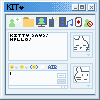
To be honest, I wasn't really sure where to start. I had a Wix site for my art, and a carrd.io for a bio, but I felt like it was really limiting. I know basic HTML and CSS, but not much else. Determined to get my own site up and running, I went to ChatGPT for help. If I wanted a site, I needed a hosting service. I decided to go with Firebase, which is run by google and has a ton of free features.
How to use npms
To connect my site to firebase, I neeeded to use an npm. I had no clue what that was, and I still only vaguely understand the concept, but I'll try to explain it as best as I can. npm stands for Node Package Manager. In programming illiterate terms, it's basically a bunch of code in a neat package that is executed via the command prompt. To be able to use these, you have to download Node JS. Install the file you just downloaded, and when it's done, follow these steps. Open the command prompt and type "node -v", enter, and then "npm -v". This will tell you what version of npm and nodejs you have installed, just to be sure you did it right.

Installing firebase
Once you have npm set up, go to your project's directory in the command prompt and type "npm install -g firebase-tools". If you run into any errors, make sure that PowerShell on your PC allows you to execute scripts by running it as administrator and typing "Set-ExecutionPolicy RemoteSigned", enter, then "Y". Assuming you were able to install the firebase tools, just follow the directions that firebase gives you to sync up your site with your code. Make sure you are logged in ("C:\>npm whoami", log in if needed "C:\>npm login") Ask ChatGPT for help if you need it. Yay!

Domain name
Once I had my site hosted on firebase, I wanted my site to have a cool name. I used namecheap to get a domain for around $1 and connected it to firebase following online instructions. I had to go through a lot of troubleshooting and headache to get the site up and running since I'm a total beginner, so hopefully this helps anyone who wants to do the same.
Coding time
With all the computery mumbo jumbo out of the way, you can start making your site nice now. To tell you the truth, most of what I knew of HTML and CSS was from a semester of coding class I took in middle school. Luckily, the internet is vast and there are plenty of resources to learn! The best place to start is w3 schools, they have basically everything you'd ever need to know about HTML, CSS, and a couple other things. I had also heard that neocities has a lot of resources for amateur coders like me who just want a small personal site, so I went on there and quickly found a ton of resources, I'll link some of them here:
SCRIPTED RESOURCES
CSS Test pages
TEMPLATERR
districts (silicon valley)
Codepen and JSfiddle are also good places to find code that you can use for your website, and so is DeviantArt if you're brave. Using other people's code is fine most of the time, just make sure the original creator is fine with people copy pasting their code, or at least make enough significant changes to it to where it becomes yours. I also used ChatGPT a LOT to code more specific things. My site ended up kinda clunky behind the scenes, so I reccomend planning it out first. I kinda just had a vague idea and went with it. Turns out coding is harder than I thought, but I like the total control I have over everything.
Tips
If you're using Visual studio to code, then you can also install extensions! My favorite is one that launches a live server where you can see all your changes taking place in a local tab, i's just called "Live Server". There's a lot more too, I kinda just used ones that looked useful.
Firebase has a LOT of stuff it can do, so I also reccomend looking through it to see what things you can do with it. You can even earn money with google ads! The firebase documentation is very long and very boring but it is essential for some things so don't ignore it if you're stuck on something.
Since I taught you how to use npms earlier, you can use as many as you want now!!! They're saved in a package.json file, make sure you have it in your project folder so you don't lose it.
There's a LOT of pages on neocities with resources to gifs and graphics for your site, make full use of them!
yay!
That's pretty much it! This post is mainly aimed at people like me who just want a neat personal website and have 0 coding experience. You're welcome to use my code for stuff but I'd at least like to be credited unless you're just taking inspiration from it and/or modify it enough that it becomes your own unique code, and don't copy my layout please! I like having a unique website, and I'd like to see other equally unique websites too. Just uh, prepare to be jumpscared by my code because it's not very pretty. If you have any questions about anything, I'd love to help you out so leave a message in the chatbox or send me a dm on discord! I hope this has helped anyone 
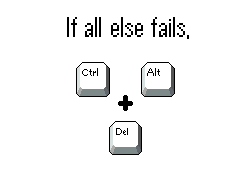
Everyone knows about the dodo. However, most common knowledge of it it WRONG and I'm here to explain why.

First and foremost, dodos were NOT stupid. An article published in the Zoological Journal of the Linnean Society in 2016 suggests that dodo brains were about the size of pidgeon brains. Pidgeons are not the smartest of creatures, but they are far from stupid, as they can be trained and can recognize faces. The misconceptioon that dodos were unintelligent arose because sailors in the 1500s noticed that the funny flightless birds walked right up to them without fear. This is actually because dodos had no natural predators in their home island of Mauritius.
In fact, one of the first names for the dodo was "Walghvoghel", which roughly translates to "tasteless/insipid/sickly bird" in Dutch... but what not many people know is that the later name "dodo" came from the dutch word "dodaars", meaning "fat-ass" in Dutch! It could have been because the Dutch thought they looked stupid, or because of the knot of feathers they sport on their tails. There are other theories that the name "dodo" comes from the pidgeon-like sound they made or other similar sounding Portuguese or Dutch words, but there is little evidence proving this. The Portuguese confused them for penguins, which is not much better.
However, one thing we do know about dodos for certain is that they were very close to pidgeons. In fact, their closest living relative is the Nicobar pidgeon, which looks absolutely nothing like the dodo but is quite genetically similar. There is a reasonable explanation for this though. Dodos... used to be able to fly! Well, not exactly. The ancestors of dodos could fly, and they landed on their little island and evolved for the next 10 million years to become dodos. The lack of predators on their tropical island and the abundance of food caused them to become big and flightless, though they were reportedly very speedy when they wanted to be.
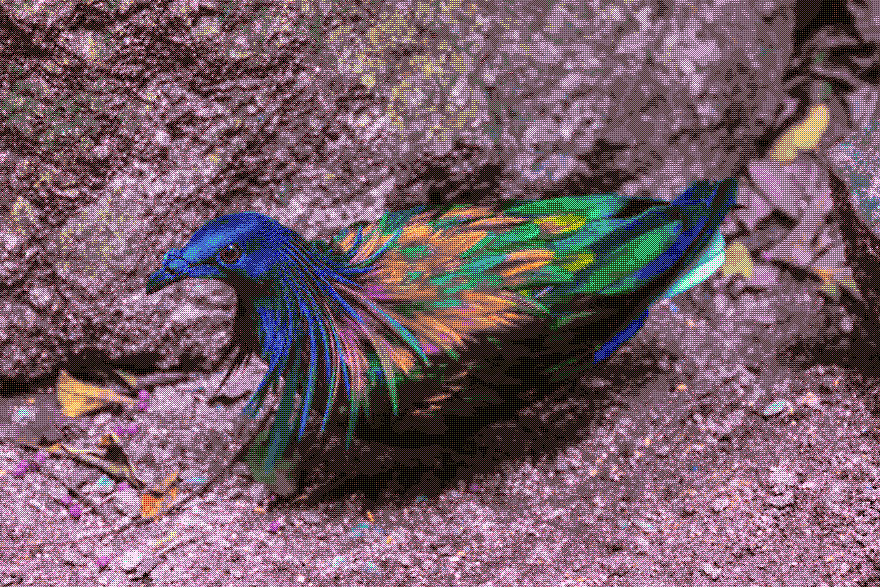 a nicobar pidgeon, the closest living relative of the dodo
a nicobar pidgeon, the closest living relative of the dodo
Dodos were often seen as shameful birds, with their dull grey feathers, silly puffy tails, comically oversized crooked beaks, little beady eyes, bald heads, and appearing wingless. They were described as greedy and offensive, eating anything, including chunks of iron. In reality, this is a rather unfair description of dodos. When the Dutch found the dodos, they thought they were so silly that they wanted to take some with them on their ship. The dodos that made it to europe onboard the ship exited as fat, overweight creatures, making them a spectacle for all to see. The Dutch overfed the dodos. Funnily enough, the only way that we know what dodos ate was because a formerly long-lost Dutch letter from 1631 dunking on rich politicians:
"The mayors are superb and proud. They presented themselves with an unyielding, stern face and wide open mouth, very jaunty and audacious of gait. They did not want to budge before us; their war weapon was the mouth, with which they could bite fiercely. Their food was raw fruit; they were not dressed very well, but were rich and fat, therefore we brought many of them on board, to the contentment of us all."
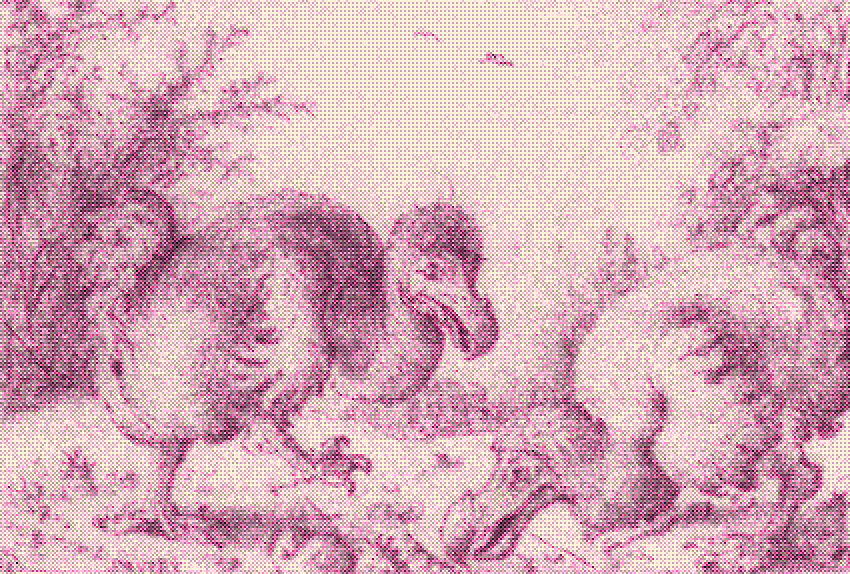 (downright offensive sketch from 1626)
(downright offensive sketch from 1626)
They also probably ate nuts, seeds, bulbs, roots, crabs, and shellfish, bestowing upon them a superb sense of smell. They also ate rocks to help them with digestion, like many birds do, explaining why they would eat iron chunks and stones that people would give them. The tropical island they resided on was also prone to natural disasters such as volcanic activity and cyclones, so dodos had to be especially hardy to survive those conditions. They might have even used their giant beaks as a weapon! The only known sketches of dodos on their native island are much fairer than the mocking sketches of ugly chickens.
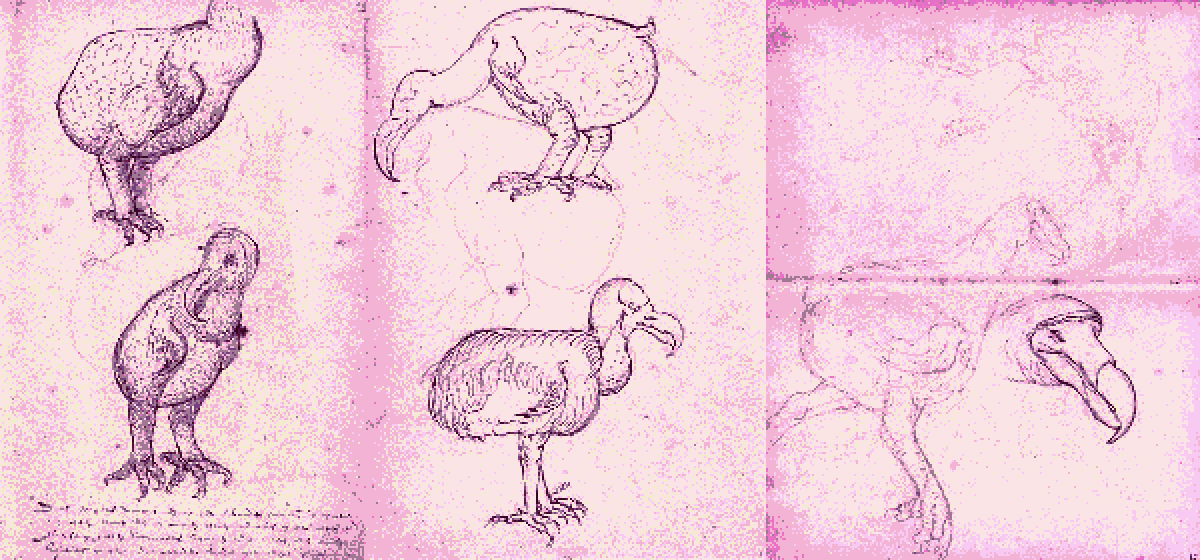 (they look rather cute, like large Kiwis!)
(they look rather cute, like large Kiwis!)
Other explanations for the famous old depictions of dodos is that the drawings were based off poorly taxidermied dodos, or dodos that were puffing out their feathers as display behavior, like an ostrich. They were also confused for red rails (a different bird native to the island) by tourists. Dodos also molted their feathers, so different stages of molting may explain some of the inconsistent accounts.
It is also widely thought that dodos went extinct because they were hunted to death by travellers. This is not true! Apart from not tasting very good (aexcept for their gizzards, apparently), not too many of them were actually hunted. The cause of their extinction is chalked up to a couple factors. When travellers set foot on their island, humans werent the only ones to unboard the ship. Pests, livestock, and pets such as pigs, dogs, cats, rats, and even monkeys scampered out and preyed on dodos and their eggs. Dodos are reported to only lay a single egg, so their slow reproduction was no match for the apetites of other introduced critters. The destruction of their natural environment was the final nail in the coffin for the poor dodos. Deforestation by humans and the sudden introduction of invasive species made their numbers dwindle, until a flash flood finally drowned the few that were left.
However, I think a more simplified version would be that dodos wanted to be friends with humans but humans did not care so they let them die. The last known dodo sighting was in 1688. However, dodos were not declared extinct until the 1800s for religious reasons as they simply did not believe in extinction, and some people didn't even believe in dodos.
We still have some remains of dodos, though only a single complete skeletal specimen. All the known taxidermied dodos are long gone. We only have a head, a foot, and a beak that were taken from living dodos to europe. Sadly, the foot has been lost. he head has also been kept in storage to prevent further degradation. We do have plenty of casts though. In addition to thatm there have been many subfossils of dodos found on their native island. At one point, the island had a massive megadrought, forcing every animal on the island to drink from a toxic bacteria-infested swamp. Many dodos perished in the swamp, which is where most of their ancient remains have been found.
Though dodo parts are rare, there are 26 museums around the world with significant dodo collections. A lot of knowledge of the dodo has been unfortunately lost to time, but this has given rise to many mysteries and rumors of long-lost information or preserved parts. There are also legends about a white dodo, but it's possible these are based off a painting depicting a whitish dodo, possibly an albino or juvenile.
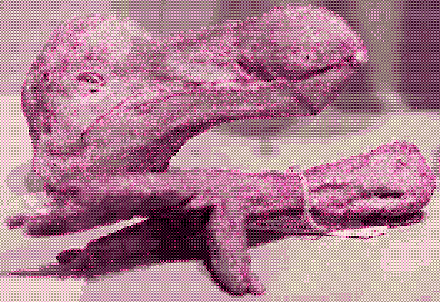 casts of the legendary head and foot
casts of the legendary head and foot
To conclude, it's a shame that the dodo bird is no longer with us, but we can still learn a lot from their story. Despite being labeled as stupid and tasteless, the dodo was a unique and fascinating bird that evolved in isolation on a tropical island. Their extinction is a reminder of the damage that humans do to ecosystems when we are not careful. Millenia of evolution and hardship was wiped away in under a century through sheer carelessness.
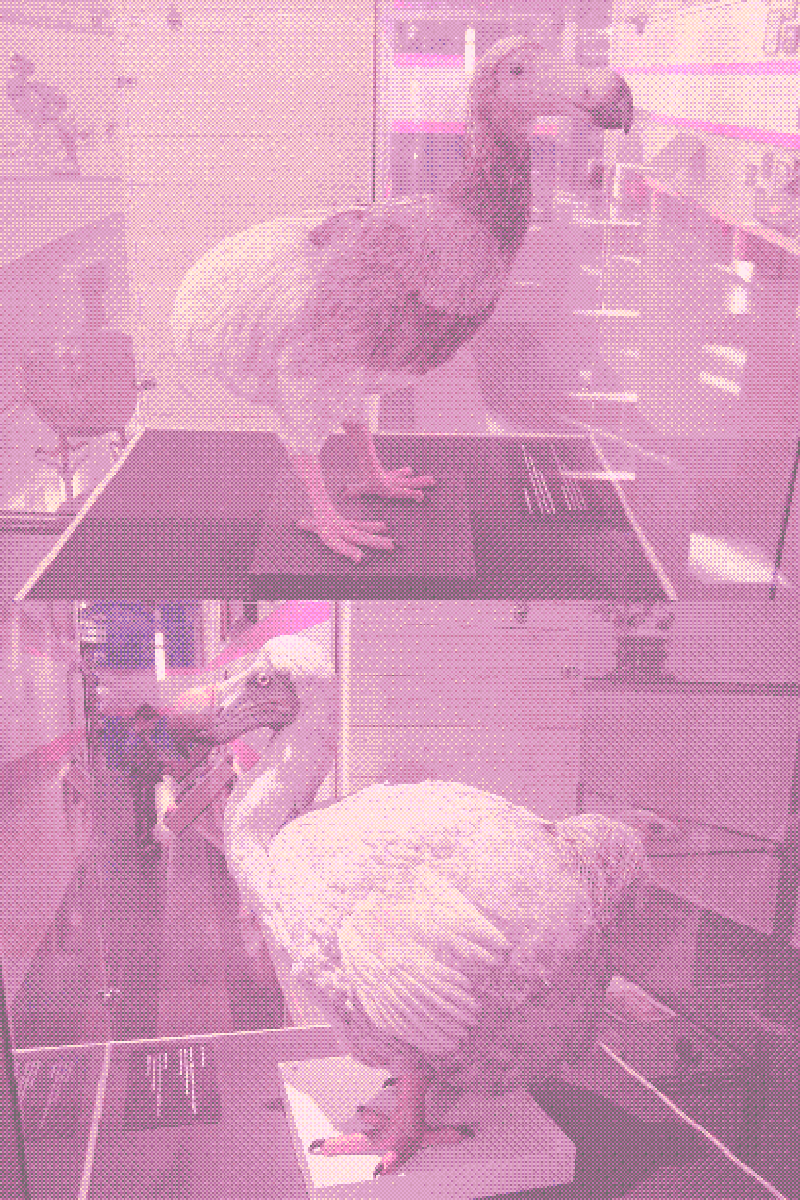 modern reconstruction (top) compared to a sculpt of the popular image (bottom).
modern reconstruction (top) compared to a sculpt of the popular image (bottom).
While it's easy to mock the dodo for its odd appearance and behavior, it's important to remember that these birds were simply adapting to their environment, just like all living creatures. We can honor the memory of the dodo by appreciating the diversity of life on our planet and striving to preserve it for future generations. Hopefully one day we will have enough DNA, funding, and public interest to bring back one of these underrated feathery creatures!
Hi! This is just a test post for my blog. Here is where I will probably be infodumping about whatever topic interests me at the moment, probably. I'm still in the process of building my site, and I have a ton of ideas but not enough skill to actually put them to use. That's why I'm using ChatGPT for help, but it's not perfect. I'm just glad I got the site up and running, but I have a huge list of things to do. I am very thankful to neocities users for providing so much free code :)